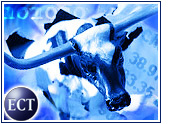
After a couple of dismal years, the Nasdaq has seen a sharp rally in the past few months, reaching its highest level in more than a year in an early June surge.
Because the Nasdaq is primarily a technology-laden index, IT companies and stockholders have watched it carefully for signs of a rebound. Unfortunately, they probably will need to keep watching.
As Larry Wachtel, a market analyst at Prudential Securities, told the E-Commerce Times, “What’s happening with the Nasdaq is basically a leap of faith.”
Should investors wade cautiously back into the market or wait for better times?
Reason for the Rally
One major factor in the Nasdaq’s rise is that, in some ways, the market is correcting itself after an oversold period.
Wachtel noted that the primary reason for the rally is that the Nasdaq was hit hardest when the economy began to spiral downward. Like a punching bag, it is swinging back to center.
“It’s simply a snap back,” he said. “When you look at the decline during that three-year period, the major decline was in technology. Since the Nasdaq is really a technology index, that’s where you saw the decline … [and] that’s where the correction is happening now.”
Righting the Ship
Although it would be refreshing if the tech sector were to shed its malaise entirely and bounce back to dot-com levels, that is an unrealistic hope. What is happening now is quite different.
“There’s just a lot of money out there,” said Mark Sellers, an equity strategist and portfolio manager at Morningstar. “The Fed has lowered [interest] rates so much that there is nowhere else to put money but into stock.”
In other words, bond returns have dropped so low that stocks’ uncertain but potentially higher returns are once again the best option for many investors.
Sellers told the E-Commerce Times that this situation has fed the rally in both the Nasdaq and the Dow, with semiconductor stocks trading at an “astronomical level.” Since semiconductors are a significant component of the Nasdaq, other sectors of the exchange usually benefit from gains in this area. As the old saying goes, a rising tide lifts all boats.
Caution Flags
Even though semiconductors are trading at relatively high levels now, however, potential investors should not view this sector as a good place to squirrel away funds at present.
“That’s what’s unhealthy right now,” Sellers said. “The semiconductors are overvalued.”
Wachtel added that although semiconductor stocks have risen dramatically, there are not sufficient signs that the Nasdaq is back at full speed with such stocks leading the way.
“There’s no indication that business has picked up for the semiconductor industry,” he said. In fact, he and other analysts said they expect the sector to decline in the future.
Weak Sector
For example, Doug Andrey, principal analyst for the Semiconductor Industry Association, told the E-Commerce Times that the uptick in spending anticipated by the SIA has not materialized.
“We’ve lowered our forecast for 2003,” he said. There are several reasons underlying this tempered hope, including a lack of spending as IT departments stretch budgets and lengthen their upgrade cycles.
SARS also has been a culprit, according to Andrey. The illness in Asia, especially when combined with unstable political conditions across the globe, has made the semiconductor industry shakier than in past years.
Still, he expressed optimism about the sector’s long-term prospects. “There is a positive future for the industry. We believe that telecom infrastructure spending will begin again, and semiconductors are starting to be used in 2.5G and 3G [wireless] handsets, which will drive demand.”
In a best-case scenario, if the industry gets a boost from increased telecom spending and greater consumer outlays for wireless devices, the Nasdaq could see another rally in 2004.
Can It Last?
Not everyone is as optimistic as Andrey, however. Sellers noted that the current rally could continue as long as the Fed keeps cutting rates. When the Fed stops, it will remain to be seen whether or not the Nasdaq cansustain its rally.
“Really, the only way it can continue is if inflation stays nonexistent,” he said. “And the chances for that are less than 50 percent.”
The other difficulty is in the weakness of individual sectors, Sellers added. “I don’t see anything in tech that looks appealing right now in terms of valuations. And I don’t expect to see anything dramatically appealing for the next couple years.”
Corporate Roadblocks
For his part, Wachtel pointed to IT policy decisions, such as fewer PC upgrades, as factors that will keep the Nasdaq from rallying to an even greater degree.
“There’s not a great incentive to build up new equipment,” he said. “Also, even though there is an obsolescence factor built in to PCs, we haven’t seen any large-scale personal computer recycling for about four years.”
The greatest obstacle to a continued stock surge, Wachtel noted, is that a major push in capital spending is required to keep stocks flying high. With money tight, that enterprise spending simply is not happening.
So, although the recent boost in the Nasdaq cannot be considered a false rally, it also would be hasty to view it as an indication that tech stocks are back on top for good. Still, it is human nature to keep on hoping — and it iscollective human nature that drives the market.



























































Social Media
See all Social Media